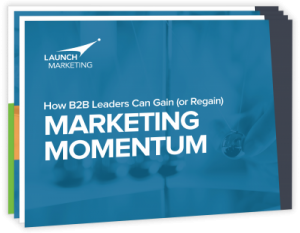
So, you’ve just completed a successful product launch – time to kick back and celebrate the culmination of all your hard work, right? Not quite. A successfully executed launch is something to be excited about, but without a rock-solid post-launch strategy, all the buzz and energy it generates will fizzle out.
Elements of a post-launch strategy can vary greatly depending on the nature of the product, service or solution launched, team capacity and bandwidth, and other factors unique to your company. Variation aside, there are three pillars of post-launch activity that we find to be essential for any organization.
Assure alignment between sales and marketing
Achieving and sustaining sales and marketing alignment is a common struggle for many organizations. Specifically, alignment here means each group having a common understanding and agreement on the shared goals, overarching strategies and success metrics that will guide their individual and collective efforts. Making certain that active communication takes place early and often is a key to preventing these groups from diverging as post-launch time ticks by.
One pivotal part of the sales and marketing alignment checklist is to remove or reduce the chances for misinterpretation of metrics and results. Formally document the definition of KPIs such as leads, including what constitutes a qualified lead and what the various stages of your lead funnel are. Solidifying these definitions and qualification criteria promotes objectivity and collaborative efforts. Omitting this step can lead to a finger-pointing environment where emotions can take over and each group may feel the other isn’t doing their part.
Read: From Link to Lift: Aligning Sales and Marketing to Boost Bottom-Line Impact
Continuously test and optimize campaigns
At Launch, we’re firm believers in the valuable insight that testing provides in shaping post-launch strategy and optimizing execution. We test everything we do, analyze the results and apply what we learn to deliver better results next time. Although you may have tested a wide range of messaging or related variables in preparing for your product or service launch, continued testing after initial launch is equally imperative.
Reflect first on your pre-launch marketing plan. Invest time to analyze results and feedback from the marketing activities used to generate excitement and engagement around your initial launch. For example, what emails delivered the strongest clickthrough rates? Which subject lines resonated most strongly in you’re A/B tests? What social platforms and post types resulted in the most engagement? Create a culture where you continuously test and apply the results to sustain your success post-launch.
Develop clear, closed loop reporting processes
Being disciplined in this step supports the aim above of keeping all stakeholders on the same page by using data (and not opinion) to illuminate what marketing activities are converting best for sales and what messages and activities are yielding the best overall results. Equally as helpful are indicators of what isn’t working so that course corrections can be made early when needed.
In general, closed loop reporting gives you objective insight into whether your marketing is heading in the right direction and doing enough to support your business objectives. Be clear about the data you need to evaluate performance, develop readable reports that inform action and consistently review and apply the findings to build a lead generation engine that lasts.
Sustain your success with your post-launch strategy
While individual post-launch strategies and approaches may vary when it comes to deciding on the right array of marketing activities or the best mix of follow-up messages to roll with, the three pillars detailed here are universal for every organization. When applied properly, they provide the foundation for a collaborative, scalable and successful post-launch future.


There are no comments